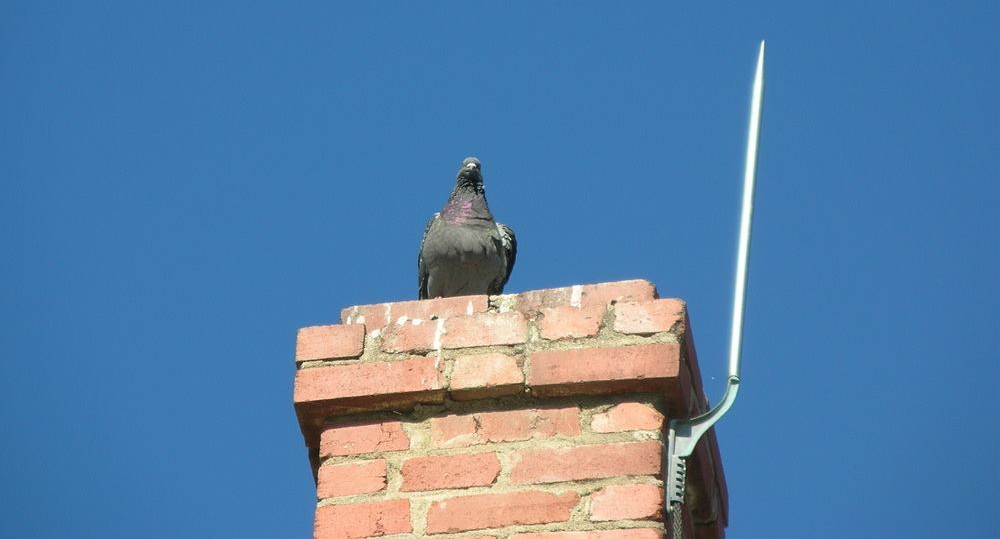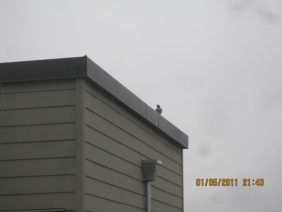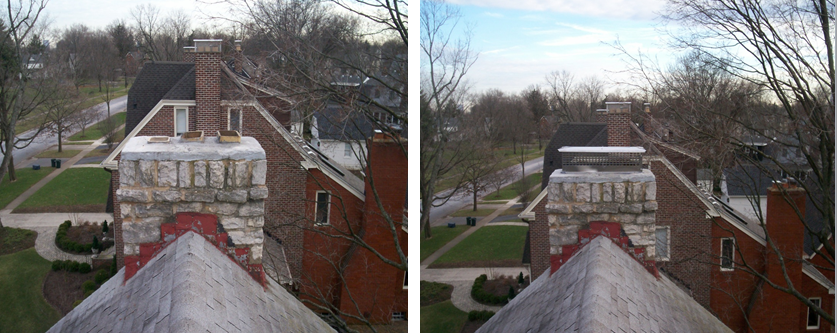
Pigeons thrive in populated areas, and chimneys provide them with the same benefits as cliffs—a nesting place that comes close to mimicking their natural abode in which they can raise their young out of harsh weather and protected from predators. Unfortunately, pigeons nesting in your chimney can cause homeowners a variety of issues. Professional bird removal from your chimney is needed. Learn more about the problems associated with birds in chimneys and our effective solutions for bird control.
Need Help with Pigeons in the Chimney?
Find a Critter Control near you.
6 Signs of Pigeons in Chimney
1. Noises from the Chimney
- Cooing, flapping, or scratching sounds, especially in the morning or evening.
- Chirping or peeping if baby pigeons (squabs) are present.
2. Nesting Materials
- Twigs, leaves, and feathers accumulate at the base of the chimney or around the fireplace.
- Debris may also block airflow, leading to a smoky fireplace.
3. Droppings Around the Chimney or Fireplace
- White, gray, or greenish pigeon droppings on the chimney cap, roof, or inside the fireplace.
- Droppings often carry bacteria and can cause health issues.
4. Foul Odor
- A strong, musty, or rotting smell if there is a dead pigeon or excessive droppings.
5. Visible Pigeons
- Birds frequently perching on or flying around the chimney.
- Seeing pigeons entering and exiting the chimney.
6. Blocked or Reduced Draft
- Smoke backing up into the house due to a nest blocking ventilation.
- Difficulty lighting fires or an unusual increase in soot buildup.
Problems Associated with Pigeons in Chimneys
While pigeons may use chimneys to enter homes, the pests more commonly set up nests directly in confined spaces. Chimneys are warm and enclosed, which keeps pigeons safe from the elements and predators and allows them to raise their young.
Fire Hazard
Most bird nests are built with twigs, leaves, and grass, all of which are quite flammable. If you light a fire when birds are nesting, even the tiniest spark can cause a fire. During summer, when these materials become dry, the risk increases. In addition, using your fireplace with a bird nest in the chimney can partially block the release of smoke. This can trap carbon monoxide in your home.
Structural Damage
Over time, bird nests can cause long-term and costly damage to the structure of your chimney. The accumulation of moisture, debris, and droppings can weaken your brickwork. Bird droppings contain high levels of uric acid. This acid is potent enough to damage brick, stone, cement, and many other materials we would normally think of as strong.
This is especially important if you have chimney swifts in your chimney. These migratory birds often return to the same place to nest year after year.
Health Risks
Birds in chimneys pose health risks and spread disease, infections, and parasites.
Bird droppings contain bacteria, parasites, and allergens affecting the lungs. Dried bird droppings grow fungi that cause respiratory diseases such as histoplasmosis and tuberculosis and can also worsen existing respiratory illnesses such as asthma.
The parasites they carry include fleas, mites, lice, and ticks. Once in your home, they are difficult to eradicate and will cause you and your pets discomfort.

Pigeon Control in Chimneys
Birds are federally protected by the Migratory Bird Treaty Act. It is unlawful to kill, capture, or harm them in any way. When you need bird removal from your chimney, the professionals at Critter Control are your best solution. We have over 40 years of experience in the humane and lawful removal of any nuisance animal in and around homes.
How to Keep Pigeons out of Chimney
Chimneys are not the only places in your home where birds cause harm. Birds of many backyard species will nest in gutters, soffits, vents, and attics too. The most effective way to keep them away from your home is with bird deterrents that make your house a less attractive roosting and nesting spot.
Sonic and ultrasonic devices emit sounds that imitate predators such as owls, hawks, and eagles. Some devices sound like gunshots, screeching, clapping, and shouting. Sonic devices emit sounds that humans and birds can hear, while the frequency of ultrasonic sounds can only be heard by the birds.
Sonic devices bring positive results quickly but can become annoying to people. Also, the birds can get used to the sound, making them less effective over time. Ultrasonic devices have multiple frequencies, so the birds don’t get used to the sounds. In addition, humans can’t hear them, so there’s no annoyance.
Visual deterrents can also be useful. These include decoys of bird predators—owls, hawks, and snakes—that scare birds away. Non-animal examples of visual deterrents include shiny objects that sway in the breeze, reflective devices, and bright balloons with large eyes or targets on them.
Bird Exclusions on Chimney

Bird exclusions are physical barriers that keep birds out or away from certain areas. Exclusions are employed after birds have been eradicated from your chimney to keep them from returning. Exclusion is a more permanent solution.
Chimney caps are protective coverings that fit on top of your chimney. In addition to keeping birds out, they will keep other wildlife, such as raccoons and squirrels, out. Made of metal, they come in different sizes and will keep rain and snow from damaging your chimney’s bricks and dampers, prevent downdrafts, and keep embers from flying out onto your roof.
Placing a chimney cap has to be done in the fall after chimney swifts have left on their migration south. When they return in the spring, they will not be able to enter the chimney to take up residence again.
Repairing and sealing around your chimney ensures chimney swifts cannot find an alternate entrance into your chimney.